Innovations in Practice: Nature in Oil Palm
In part 2 of the Innovations in Practice: Nature in Oil Palm article, Wild Asia continues its collaboration with various partners to develop nature-based solutions that support smallholders’ and growers’ sustainable oil palm journeys.
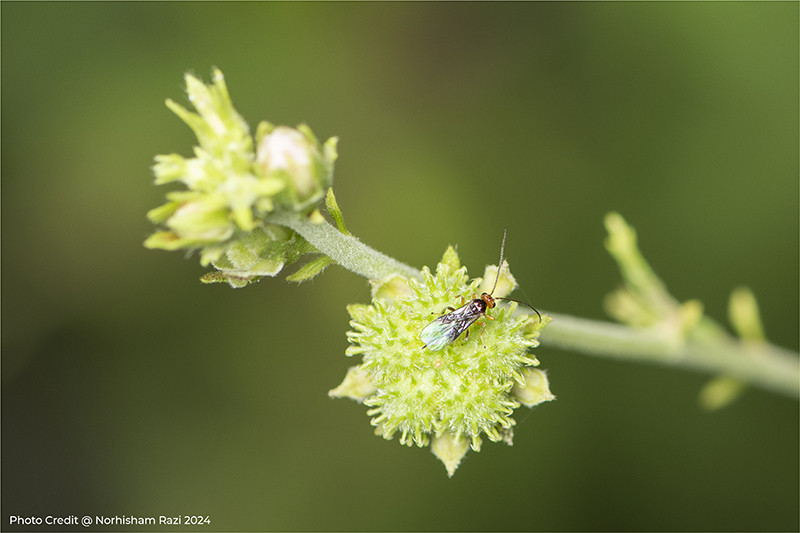
Braconid wasp Cotesia on Pepulut/Caesar weed (Urena lobata) flower bud.

The BEFTA Project
For the BEFTA Project, Wild Asia partnered with the University of Cambridge to understand and quantify the existing levels of biodiversity, ecosystem functions, and yields on smallholder plots. The project is an extension of the BEFTA (Biodiversity and Ecosystem Function in Tropical Agriculture) programme, a large-scale experiment to investigate ways that tropical agricultural ecosystems can be managed to benefit biodiversity, associated ecosystem services (such as pest control and decomposition), and to increase the long-term sustainability of crops.
The early stages of the project, launched in Indonesia in 2013, were a collaboration between Cambridge and Sinar Mas Agro Resources and Research Institute (SMARTRI), which focused on large-scale oil palm plantations.

However, applying the results to smallholder farms is a different ball game. Hence, Dr Turner’s team reached out to Wild Asia due to their expertise and experience working with smallholders.
“We were also eager to include Malaysia and Indonesia in the project, as these are the two biggest producers, and the smallholder context and the management's differ between countries,” Turner adds. His team also works with smallholders in Riau (Indonesia) through SMARTRI.
The BEFTA Understory Vegetation Project, which includes researchers and oil palm experts from Malaysia, Indonesia, and the UK, aims to quantify smallholder farmers’ attitudes to biodiversity and management practices, biodiversity and ecosystem processes, yields, as well as profitability. From June 2021 to November 2022, WA’s field team conducted social, environmental, biodiversity, and greenhouse gas (GHG) surveys in 50 MSPO-certified smallholdings, including WAGS BIO farms, in Perak.
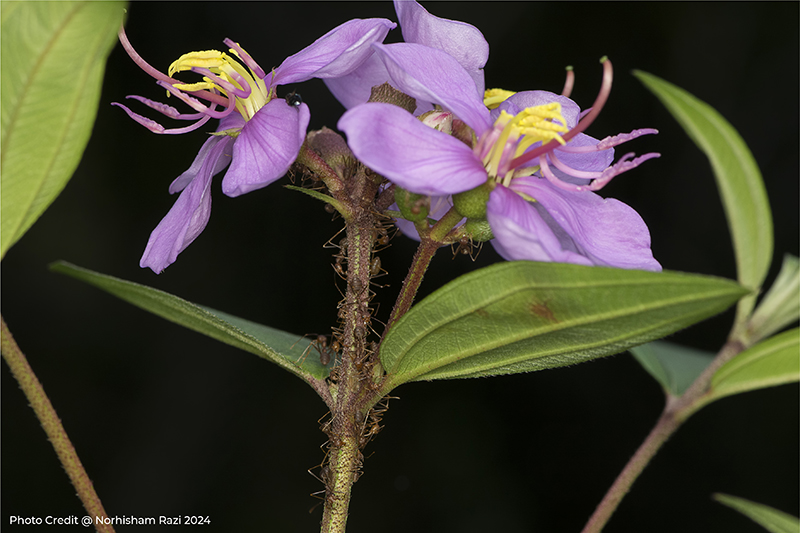
Weaver ants that help combat bagworms found in Sendudok (Melastoma) flowers.
The surveys collated information on the farmers’ chemical usage, their farms’ understory and cover, insect diversity and population, as well as soil and tree health. Although Dr Turner’s team is still processing the data in more detail, they have uncovered some preliminary results.


“We have yet to understand the correlation between epiphyte presence and higher yield, but it fits the narrative of how increased diversity benefits the palms,” says John Howes. “It’s also intriguing that these vertical gardens on the palm trunks probably play an important role in recycling and feeding nutrients into the root zone at the base of the palm.”
Ultimately, the BEFTA results will generate crucial information on how best to manage ground vegetation in oil palm farms to optimise the benefits for biodiversity, ecosystem functions, and crop profitability.
“We’d like to combine the results from the Cambridge understory vegetation study with the Sustainable Agriculture Network (SAN) project to promote understory growth management that incorporates elements of cut and drop (trimming and letting the understory decompose naturally on the ground), beneficial plant reservoirs and insect refuge to increase biodiversity and interconnectedness - specifically along natural corridors such as water courses and edges, and manmade structures like road verges,” Howes adds.
Realities on the Ground
For smallholder farmers, the common barriers to adopting nature-friendly approaches range from limited resources - time, money and energy- to understanding agrochemical usage and soil conservation.
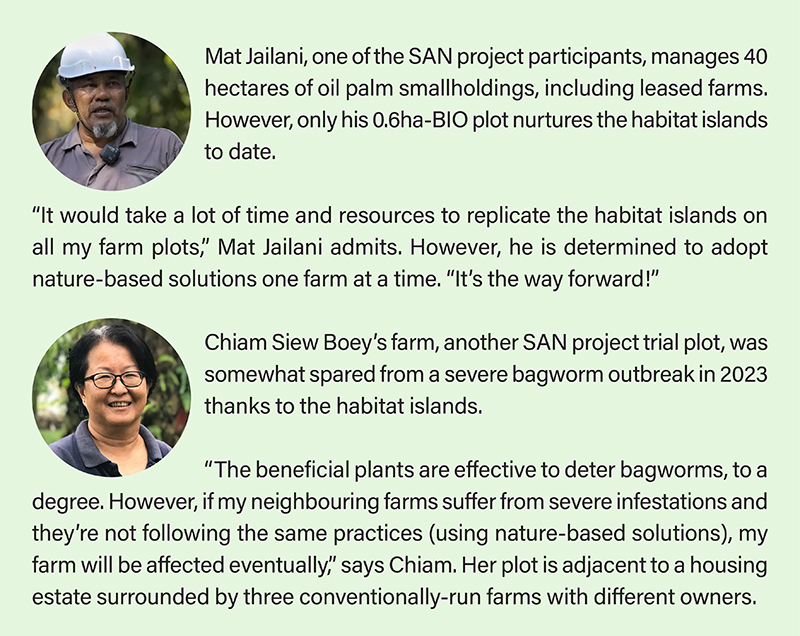
During SAN’s initial survey, SAN Senior Technical Advisor, Oliver Bach explained that rampant use of agrochemicals was common amongst farmers, affecting important plant resources for beneficial insects and influencing these organisms’ soil life and larval stages.
In 2023, SAN and CABI jointly conducted an integrated pest management (IPM)/Pesticide Training-of-Trainer workshop to teach WA’s field team practical tools for IPM and safe pesticide application in oil palm. In May 2024, WA ran the first training for smallholders in Perak on safer alternatives to banned or harmful agrochemicals and how to calculate chemical concentrations. A similar workshop for Johor-based smallholders is lined up for August.
Changing Mindsets
Fundamentally, these projects and initiatives are only as good as the farmers willing to change their mindsets. One prevalent notion is that oil palm estates or farms should be free of straggly shrubs or understory.
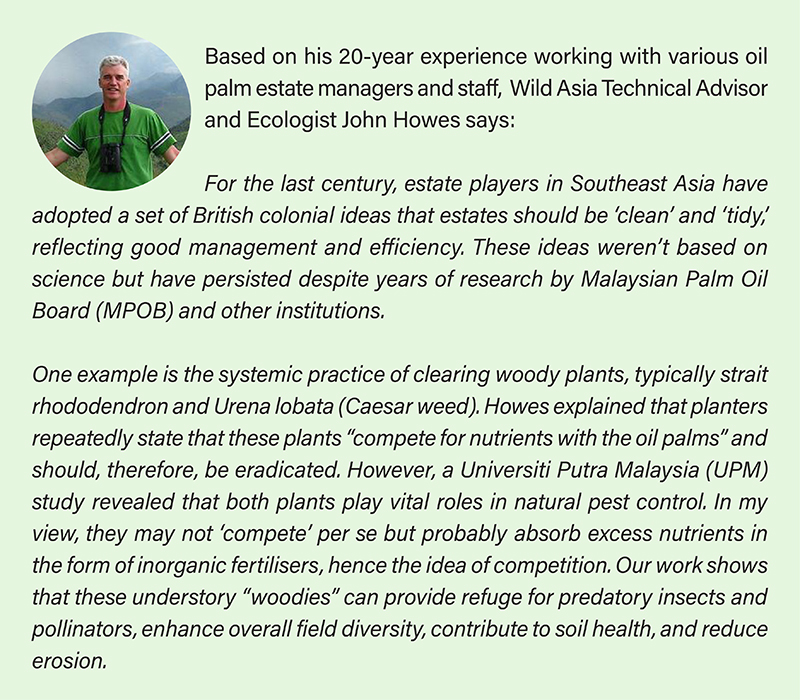
Also, preliminary data from the BEFTA project indicates that income and socio-economic factors correspond with farmers’ levels of participation in partnership schemes like the Wild Asia Group Scheme or WAGS BIO. Across Southeast Asia, oil palm has historically been farmed as a profit-driven crop, lacking its cultural or sustenance background it has in its native West Africa. Smallholders are more likely to participate in schemes and adopt sustainable practices if there are financial incentives or premiums generated by certified palm oil.
Howes also believes that the key to changing mindsets is the farmers themselves. Many WAGS members are off-site farmers who employ contractors to do the grunt work and prioritise efficiency at low costs.
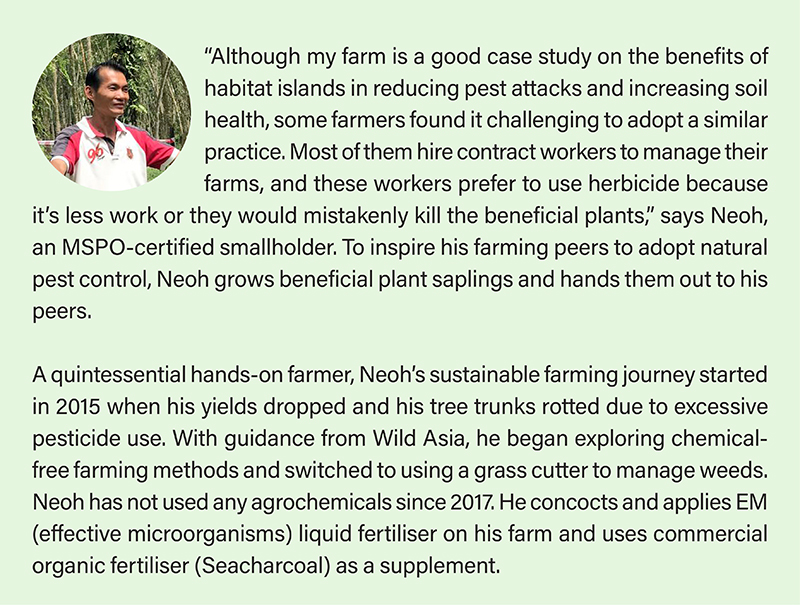
“Those farmers who actually farm are the ones who care enough to change things,” adds Howes. “We need more local champions like Neoh and Mat Jailani to inspire others. Likewise, the estates need to see the benefits and profits before they’re willing to move forward.”
The Big Picture
Farm management aside, landscape management and partnerships should be part of the overall equation, Howes added.
Howes reiterates, “We must take a landscape approach in planning to protect biodiversity, ecosystem functioning, and the robustness of our agricultural systems.”
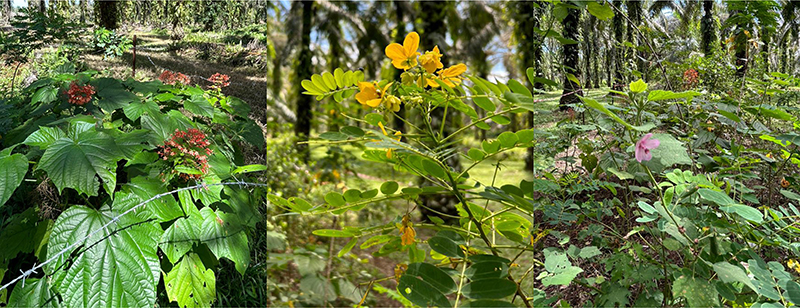
Chiam Siew Boey’s habitat island grows beneficial flowering plants such as Sickle pod (Cassia tora) and Pepulut/Caesar weed (Urena lobata).
Recent studies have shown that an oil palm landscape with diverse and complex vegetation and connectivity can support biodiversity and provide economic benefits. Connected landscapes and corridors can also provide habitat for beneficial predators and balance ecosystem processes. The authors also stress “the importance of using land-sharing and land-sparing techniques simultaneously—setting some land aside from human use for conservation and integrating conservation practices on land being used.”
“Landscape connectivity is the key concept for the future,” says Howes.
However, the government must provide stimulus and work with local authorities and environmental organisations to make it happen. Most landowners (estates) must be aware of their responsibilities, and smallholders can take advantage of incentives. “Farmers and estates are the stewards of our landscapes. And if Wild Asia can show what that stewardship means and what it entails, I believe we can change the face of monoculture in Malaysia,” Howes sums up.
Big dreams, perhaps. But the wheels are already in motion.
* In a 2021 project in Costa Rica, SAN helped build the capacity and skills of smallholder farmers from an oil palm and cocoa cooperative to implement sustainable agricultural practices.
** An epiphyte is a plant, like ferns and orchids, that grows on another plant (e.g., on tree trunks). The results of SAN Phase 1 and 2 are now published in the journal Cogent Food & Agriculture (OAFA): A. R. Norhisham, M. S. Yahya, S. N. Atikah, J. Syari, O. Bach, Mona McCord, J. Howes, and B. Azha. (2024). Non-crop plant beds can improve arthropod diversity, including beneficial insects in chemical-free oil palm agroecosystems. Article ID: OAFA (2367383).
References
- *Mexzón, R.G. and Chinchilla, C.M. (1999) Plant species attractive to beneficial entomofauna in oil palm (Elaeis guineensis Jacq.) plantations in Costa Rica. ASD Oil Palm Papers (Costa Rica) No.19 (pp. 23-29)
- MPOB (2016) Standard Operating Procedure (SOP) Guidelines for Bagworm Control. Malaysian Palm Oil Board, Bangi. 41 pp.
- Sustainable Agriculture Network (SAN) ‘s IPM Resources include presentations relevant to the SAN-Ferrero project.









